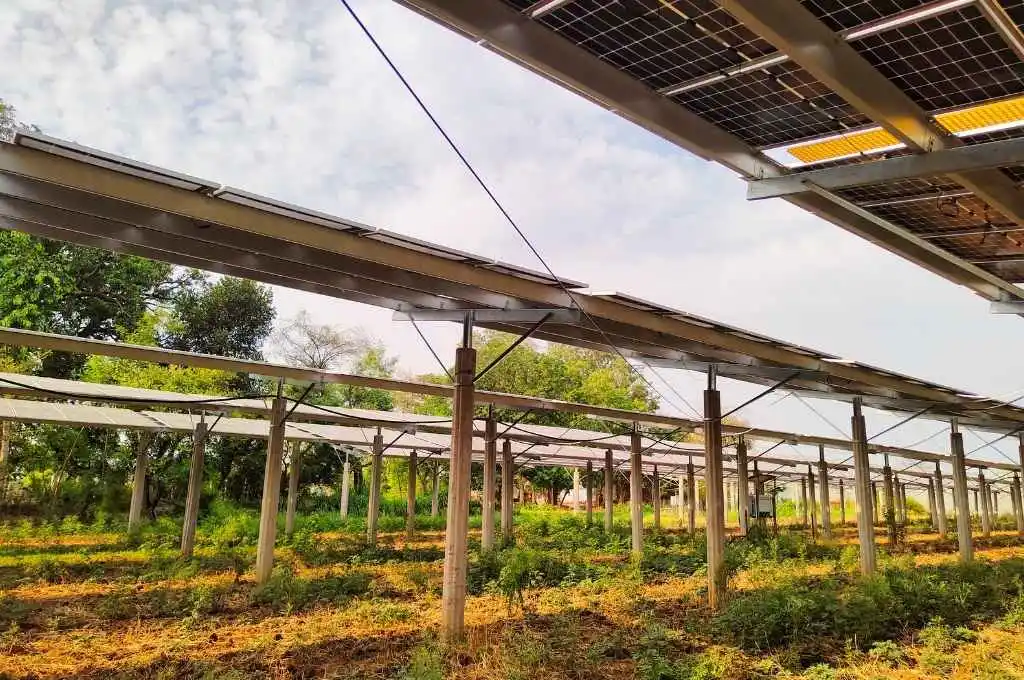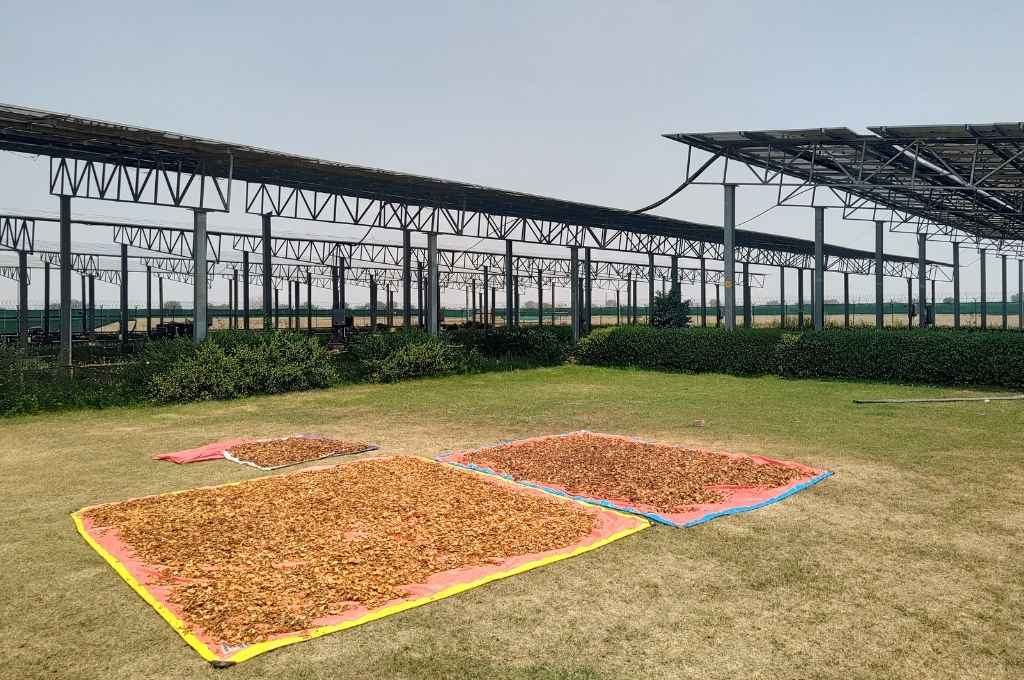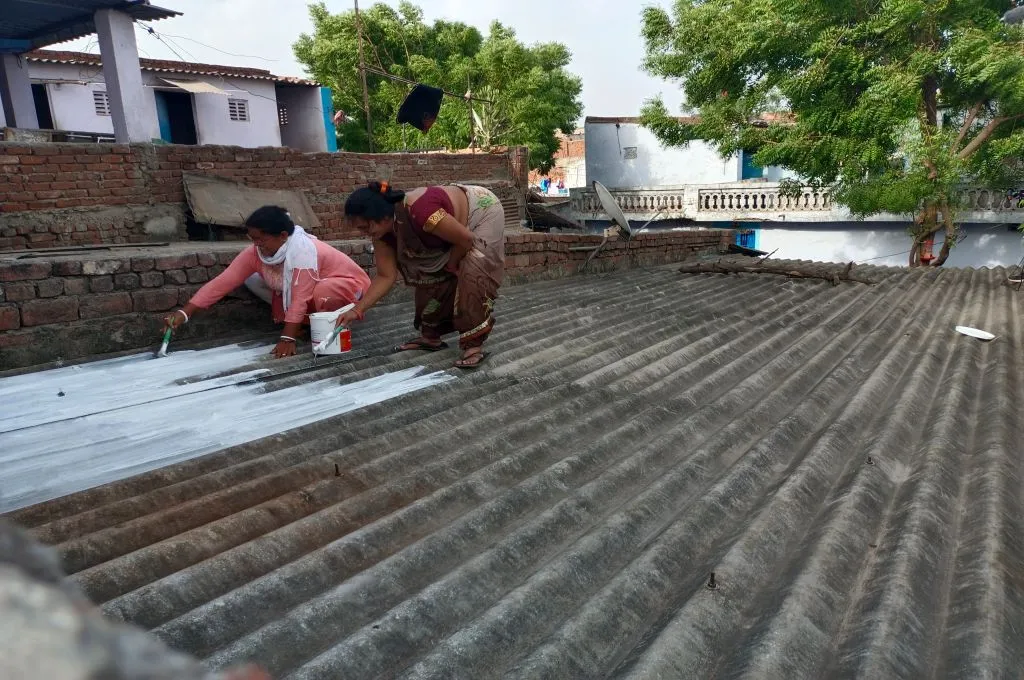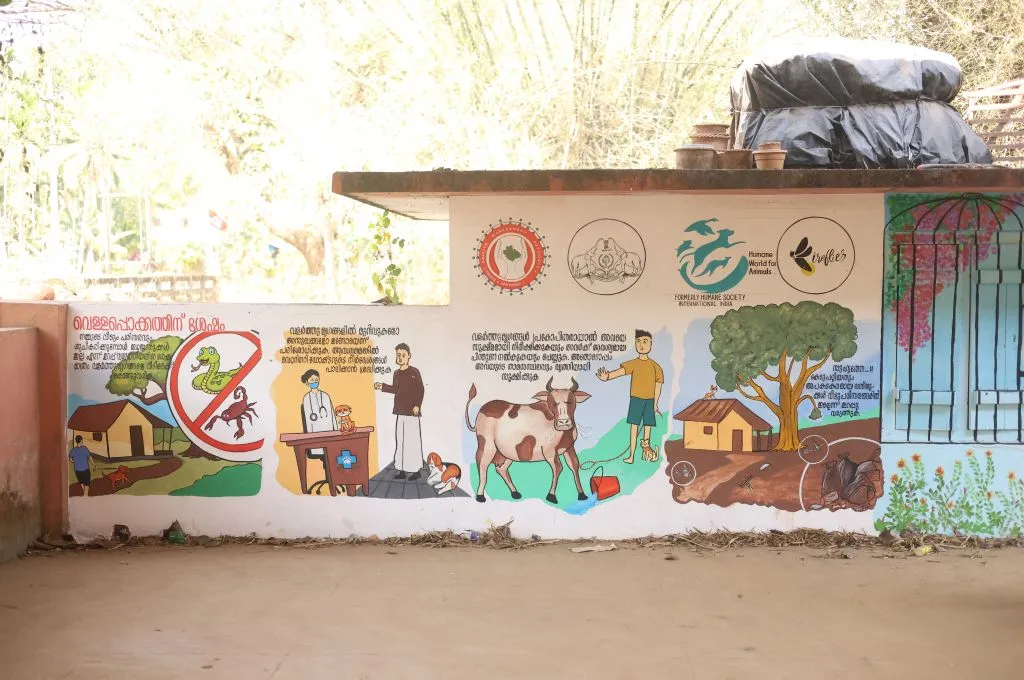Solar panels have become a recurring motif in our landscape. Their rectangular panes signal clean energy production across rural and urban India in the form of large-scale utility solar parks, decentralised projects, rooftop installations, as well as solar pumps. In October 2024, solar power capacity stood at 92.12 GW; the Central Electricity Authority (CEA) expects it to increase to 270–293 GW by 2030, accounting for an estimated 58–60 percent of non-fossil fuel capacity.
However, there are concerns that the expansion of the solar sector comes at a cost to the agricultural sector. A study reveals that more than 40 percent of the country’s solar farms are located on agricultural land, putting both food production and rural livelihoods at risk.
Agrivoltaics have emerged as a solution to this problem
Agricultural photovoltaics (APVs), also known as agrisolar or agrivoltaics, are decentralised solar energy systems that situate agriculture and solar energy production on the same plot of land, with farming practised beneath and/or between solar panels. It is, therefore, a renewable energy (RE) system that conserves agricultural productivity and simultaneously produces electricity.

This innovative approach also allows for the reclamation of barren and degraded land for the dual purposes of electricity generation and agricultural production. Additionally, it encourages farmers to participate in the energy transition by providing them with opportunities to diversify their income and enhance economic resilience.
With more than 180 million hectares of arable land, India stands to harvest a rich crop of energy from agrivoltaics. The report Agrivolatics in India published by the German Corporation for International Cooperation (GIZ) pegs the country’s agrivoltaic potential at 3.1–13.8 TW in a conservative-to-best case scenario. However, the commercialisation of this solar application is a long way off, and the field is still being studied.
There are more than 25 pilot projects in the country attempting to understand the impact of agrivoltaics on a host of metrics, including crop yield, groundwater levels, energy output, soil conditions, the type of crops that can be farmed under different types of modules, and, crucially, the cost revenue ratio of such systems.

Types of agrivoltaic systems
Agrivoltaic systems can be configured in three ways, which determine the type of crops that can be grown beneath or between them.
1. Overhead configuration: These modules are raised at least 2 metres off the ground, allowing farming to continue below them. In some cases, the height also allows for the use of heavy machinery such as tractors. The 110 kW capacity plant run by the Krishi Vigyan Kendra (KVK), Delhi, with panels elevated up to 3.5 metres, is an example of this system.

2. Conventional ground-mounted configuration: Located close to the ground, the panels allow for interspace farming between them. Cochin International Airport, the world’s first fully solar-powered airport, has been running a 4 MW agrivoltaic plant with panels arranged in this manner. The 20-acre plant produced approximately 90 metric tons of vegetables from 2021 to 2022.
3. Vertically mounted systems: The solar panels here are mounted vertically on the borders of the farmland (like a wall) to optimise land use, with crops planted between mounts. Such a system produces maximum energy at sunrise and sunset and works well for crops that need sun exposure. A 5 kW pilot near Gurugram, Haryana, run by the National Institute of Solar Energy, is an example of a vertically mounted system.
There are also projects—such as the 1.4 MW plant near Parbhani in Maharashtra—that have deployed hybrid layouts, using both interspace and elevated modules. Plants such as cherry tomato, betel leaves, cucumber, and roses grow below the elevated panels, while watermelon grows in between.
Business models
Through our work, we have seen four business models. Each of these has been developed keeping the farmer—both the landowners and the cultivator—at the centre.
- Developer-owned, where plants are owned and run by developers on land leased from farmers. Farmers continue to cultivate the land and take home the harvest.
- Developer-cum-farmer-owned, where the farmer is the owner and developer of the plant.
- State- or DISCOM-owned, where electricity distribution companies own the plant and meet their renewable purchase obligation (RPO) targets with the power it generates.
- Community-owned, where farmers or community members collectively own and run the plant as a farmer producer organisation (FPO) or cooperative.
The nature of the agrivoltaic ownership model determines the benefits—such as tax credits and subsidies awarded to owner groups—that the plant will enjoy. The ownership model also dictates land conversion from agricultural to non-agricultural land owing to PV installations.
Stakeholder benefits
Food and energy security, and increased land use efficiency are the broad advantages of agrivoltaics. Here’s a list of some of the additional benefits that accrue to individual stakeholders:
Benefits to farmers
1. Increased income: Agrivoltaics gives farmers the opportunity to increase and diversify their income stream through farming, land leasing, power generation, or some combination of these. When farmers have only agriculture to rely on, their income arrives at the end of the agricultural cycle and is subject to variables such as weather, water, minimum support price (MSP), supply chains, and market dynamics.
Agrivoltaics can earn farmers a steady revenue through the sale of power or land lease rentals, thereby increasing their cumulative income, reducing financial stress, defraying the cost of agriculture, and allowing them to earn between cropping cycles when the land is left fallow. In addition, the energy security provided by agrivoltaics enables farmers to operate cold storages and processing facilities, thereby establishing a value chain for their produce and yet another revenue stream. The Najafgarh plant in Delhi, operated by Sunmaster, serves as an excellent example. Through its lease model, the plant has reportedly enabled the farmer to increase his income four-fold, from INR 30,000 to INR 1.2 lakh per acre per year.
2. Efficient water use: The shade provided by solar panels reduces the evapotranspiration rate of plants and helps the soil retain moisture. This reduces soil erosion and degradation, and increases the water use efficiency of the land; this is especially useful for agricultural activities in dry, arid regions.
Water is simultaneously optimised by deploying it for the dual purpose of panel-cleaning and irrigation. Some modules are even designed with ducts to collect and channel rainwater harvested on site. Up to 1.5 lakh litres of rainwater is annually harvested at the CAZRI plant.
3. Crop diversification: The shade cast by the panels on the ground can result in a unique microclimate conducive to the growth of new plants, allowing farmers to diversify their production. At the Sunmaster plant, for instance, farmers grow turmeric, brinjal, lettuce, potatoes, mango, and pomegranate in the shade of the panels. Compared to the neighbouring fields that only cultivate wheat and mustard during the four months of the rabi season, the agrivoltaic plant is active throughout the year, facilitating horticulture production underneath the panels. This enables farmers to earn marginally more than their neighbours.
4. Electricity self-sufficiency: The agricultural sector receives highly subsided and, in states like Punjab, free electricity. But rural power supply through grid lines has also been erratic and beset with voltage fluctuations. On the other hand, on-site electricity generated through agrivoltaics can help farmers become energy independent, and a portion of what’s produced can be utilised on the farm itself. The electricity generated by the agrivoltaic plants also helps supply reliable daytime power to neighbouring villages.
Benefits to rural communities
1. New jobs: Agrivoltaics don’t simply double the productive potential of land; they also multiply job opportunities for the local community. A field that formerly only hired agricultural labourers will now employ module installers, technicians, guards, and managers. The GIZ report estimates a demand for 1.1 to 3.38 lakh fulltime–equivalent jobs in the sector by 2040. A farmer-developer in Tikamgarh, Madhya Pradesh, has hired seven to 10 local labourers to work on his 1.2 MWp agrivoltaic plant, training them to operate the plant and farm. New roles help diversify agricultural labourers’ skills and increase their income.
2. More jobs: Farm-based, value-addition food industries can become hubs of local employment for women and youth, thereby strengthening the rural economy.
Benefits to developers and investors
1. Revenue: Developers earn revenue from the sale of electricity to DISCOMs under the PM-KUSUM scheme. While agrivoltaic systems are expected to incur higher capital investment than conventional PV systems, efforts are being made to secure better tariffs for them. This is expected to materialise once the definition of agrivoltaic systems is notified by the government.
2. Financial benefits: Soft loans and a potential tax exemption due to the retention of agricultural land are additional incentives being explored for agrivoltaic systems.
3. Increased module efficiency: Research suggests that the microclimate created under the PV panels leads to increased module efficiency. This is because the cool ambient temperature created by the plants reduces the temperature of the panels and improves their performance, allowing them to generate more electricity from sunlight.
Benefits to DISCOMs
DISCOMs are required to purchase a minimum quantum of electricity from renewable energy sources under the RPO rules framed under the Electricity Act 2003. Electricity from renewables, particularly solar PV, is currently cheaper than new coal-based power (INR 2.5 kWh for new solar compared to INR 3.5 kWh for new coal), which makes it economically feasible for DISCOMs to procure more solar power. Being cheaper and easier to set up than large solar parks, agrivoltaics can help scale India’s solar capacity, making the price of solar energy even more competitive. This is contingent, of course, on improved transmission and distribution (T&D) infrastructure.
When power is generated and consumed at the load centres, transmission and distribution grid losses are reduced. This is known as avoided loss benefit. When supplying electricity to remote, rural areas, transmission and distribution losses can be as high as 40 percent. Electricity thus lost translates into financial losses to the DISCOM. This burden is further compounded by the high cost of supplying heavily subsidised electricity to agricultural consumers.
Benefits to governments
Concerns over the diversion of potential arable land for infrastructural projects such as energy production, along with the attendant social problems of displacement and lost livelihoods, have cast a shadow over the solar sector in India. By avoiding potential land use conflict and securing the vast (but disaggregated) acreage needed for solar generation, agrivoltaics pave a sustainable path to India’s twin targets of 280 GW solar capacity by 2030 and net zero by 2070, while maintaining food security.

What the sector needs to grow
The optimism around agrivoltaics must be followed up with clearly defined actions that can help the sector scale. The India Agrivoltaics Alliance (IAA), a consortium of organisations committed to developing and promoting agrivoltaics in the country, has taken a step in this direction by drafting guidelines for the sector’s growth. Here’s a summary of some of the key recommendations advanced by the IAA (of which TERI is a member) and others in the field:
1. A standardised definition
The broad conceptual contours of agrivoltaics are understood, but India still lacks a standardised definition and criterial framework, which can slow down uptake and riddle the sector with uncertainty. Several questions remain unanswered. For example, what percentage of agricultural land should be given over to PV modules? What is the optimal height for PV structures? What’s the maximum percentage of crop yield loss permitted? Are aquaculture and animal husbandry counted as agrivoltaic activities? Can cropping carried out under a 5 kW solar pump and a 2 MW installation both be categorised as agrivoltaic plants?
Germany, for instance, defines the eligibility criteria of agricultural land for two categories of agrivoltaic systems: clear height and ground level installations. Italy mandates that no less than 70 percent of the surface area of a plot be reserved for agricultural activities. India too needs a clearly articulated framework.
2. More research and development (R&D)
We need targeted R&D in agrivoltaics across different agro-climatic zones, with pilots led by agricultural universities and local KVKs in each zone. These pilots can help develop a crop matrix tailored for local climatic conditions and available resources such as groundwater, soil type, and local soil conditions. Older agrivoltaics projects failed to consult with KVKs and agricultural institutions to identify suitable crops for cultivation. They favoured exotic varieties rather than experimenting with locally prevalent crops, which could have enhanced the agrivoltaic plant’s relevance and sustainability. Eventually, projects that demonstrate improved crop adaptability to varying meteorological conditions, adopt effective soil management strategies, and leverage mechanisation effectively are bound to succeed over those that fall short on one yardstick or the other.
Robust data collection systems must be implemented to monitor and showcase the overall benefits of agrivoltaics.
Findings from research in agrovoltaics can have a cascading effect on PV plant design technology, with modules made more adaptable to different farm conditions and crop criteria. For instance, bifacial PV modules—those that absorb sunlight from both sides of the panel—work well for agrivoltaics. When installed at a height, the panel’s bottom side absorbs light reflecting off the ground, enabling it to generate more power. On the other hand, semi-transparent modules, which throw a diffuse shadow on the ground, benefit crops that need moderate light.
Research studies must also consider new innovations in rainwater harvesting and groundwater management to optimise available water resources and create a circular water management system. At the same time, effective waste management strategies should be implemented across the project’s life cycle.
The sector’s growth is clearly contingent on research across several domains and the integration of techniques and technologies. To this end, robust data collection systems must be implemented to monitor and showcase the overall benefits of agrivoltaics. Large-scale sites that failed to install robust data collection frameworks—often because they did not prioritise research—lost out on the opportunity to quantify the advantages of agrivoltaics. Likewise, experimental agrivoltaic plants with substandard solar infrastructure, such as poorly designed modules, faulty wiring, and inadequate earthing, compromise agricultural and solar outcomes as well.
3. Awareness and advocacy
Ideally, all agrivoltaics should be farmer-centric and have them participate actively in the project. In reality, farmers have shown scant interest in the technology. This is largely because farmers—particularly small and marginal ones, who own 80 percent of land holdings in India—have yet to grasp the economic benefits of energy generation. Those who have been won over to the concept continue to grapple with concerns regarding investment, the 25-year land lease lock-in, and maintenance and ownership worries.
Lack of awareness among these critical stakeholders has given developers the upper hand. Several projects have been developer-led and dominated by industry voices, with limited participation from farmers. This has resulted in partisan decision-making.
KVKs and local panchayats can conduct awareness programmes to allay farmers’ fears.
KVKs, with the help of local panchayats, can level the field. They can conduct awareness programmes to allay farmers’ fears of income loss, reluctance to experiment with new crops, and lack of knowledge about the advantages of agrivoltaics. These programmes can also guide them on how to get started with agrivoltaics by conducting training programmes, informing them about financing options, and selling them quality seeds and fertilisers. KVKs can also take the lead in collectivising farmers and commissioning agrivoltaic plants.
Clearly defined agreements between developers and farmers are essential to facilitate fair benefit-sharing—the push that can only be facilitated through policy.
4. Policy
Agrivoltaics should be marked out as a separate sub-sector within solar PV, with its development guided by a dedicated set of policies that cover the following themes:
- Land use policies and dual-use land permits should be made flexible, permitting the land to retain its agricultural status while allowing it to be used for commercial activities such as power generation. A good example of this is Delhi-NCT’s Agriculture-cum-Solar Farm Scheme, which permits stilted solar development on agricultural land to preserve its agricultural profile.
- State electricity regulatory authorities should set fixed feed-in tariffs for agrivoltaic projects for electricity supplied to the grid. These tariffs can initially be set at a higher rate than conventional power to incentivise the sector, make agrivoltaics financially viable, and reduce investment risks.
- FPOs and other rural cooperatives, either independently or in partnership with developers, should be incentivised to pursue agrivoltaic development as investors, developers, operators, or installation and maintenance service providers. Ways to achieve this include providing such collectives with low interest loans, including agrivoltaic as a priority sector for bank loan schemes, and extending tax benefits to investors.
Policy frameworks should include key performance indicators (KPIs) to quantify the benefits for farmers.
5. Improved distribution infrastructure
Extensive and efficient evacuation and distribution infrastructure is critical to the sustainable growth of agrivoltaics. DISCOMs must prepare for the emerging network of distributed agrivoltaic plants by ensuring that they are well connected to power grids and provided with the capacity to meet voltage and frequency requirements. However, DISCOMs have been slow to connect decentralised plants to the power grid, either due to reluctance in investing in last-mile infrastructure or because their RPO targets have already been met by large-scale solar plants.
Such apathy could hinder the deployment of agrivoltaics. The government can incentivise DISCOMs to support the agrivoltaics sector in several ways, such as waiving off interstate transmission system (ISTS) charges for agrivoltaic power. This waiver is currently only extended to the interstate sale of large-scale solar and wind power.
6. Periodically renewable land leases
Farmers who lease their land to developers for long-term RE projects (25 years or longer) may worry about the income they stand to lose when market rates appreciate in the future. One way to ensure that the project continues to be economically viable for farmers is to review and update the lease to prevailing market rates every five years or so, or to have a fixed periodic increment written into the agreement.
Policies must guard against the tendency of commercial developers to edge the farmer, and agricultural activities, off the land. The lease rental agreement may protect the farmer’s ownership of the land but may not guarantee their right to farm it. This risk must be addressed, and lease documents and other contractual agreements should have stringent checks and balances to make sure that the rights of the farmer, and farming itself, are protected.
The Delhi Agriculture-cum-Solar scheme, for instance, guarantees the farmer a rental increase of 6 percent per annum, starting at INR 8,333 per month per acre; free electricity from the solar plant, capped at 6,000 units per annum per MW plant capacity; the right to carry out agricultural activities for the period of the lease agreement; and complete insurance of the project, paid by the developer. Legal guardrails help protect against scenarios that privilege energy generation over agricultural productivity and social objectives.
7. Financing
Avenues such as CSR and the National Agriculture Infra Financing Facility can be tapped for agrivoltaic development and power utilisation, which includes financing the agrivoltaic value chain. Developers and investors may also consider agrivoltaics as a part of their own corporate social responsibility (CSR) initiatives and community development efforts.
In addition, viability gap funding should be extended to agrivoltaic developers to cover a percentage of the cost of the project, capped at a certain capacity.
8. Inclusion in the PM-KUSUM scheme
The PM-KUSUM 2.0 scheme is set to include agrivoltaics under its banner. Version two follows the original scheme, which promotes the all-round solarisation of agriculture, and includes the installation of decentralised solar plants, the solarisation of agriculture feeders, and the installation of both grid-connected and off-grid solar pumps.
However, as previously stated, clear-cut thresholds and standardisation of such systems for optimum height, crop and land loss, and the portion of land to be utilised for the agrivoltaics must be established. This will only occur if the data emerging from existing pilots is consolidated to produce preliminary thresholds for key parameters, and will be further refined when pilots emerge across agro-climatic zones, with different crops.
9. Community welfare
The positive impacts of an agrivoltaic plant should be felt by the larger community. Solar-powered electrification must extend to villages in the vicinity of the plant, and sustainable livelihoods— with round-the-year employment opportunities rather than one-time commissioning jobs—should be created for the community. In fact, community engagement should be integrated throughout the life cycle of the project to ensure shared ownership and trust.
Agrivoltaics is a fledgling system in the RE sector. This gives stakeholders an opportunity to ground it in policy frameworks and market mechanisms that can shape its development in ecological, equitable, and sustainable ways—in other words, embed it with the values of responsible RE. It’s what will ensure a bright forecast for the sector.
—
Know more
- Read this article to understand the role that businesses can play in seeding equity and sustainability in the RE sector.
- Listen to this podcast for a summary of the GIZ report on agrivoltaics in India.
- Watch this video to learn more about the agrivoltaic plant at Cochin International Airport.






